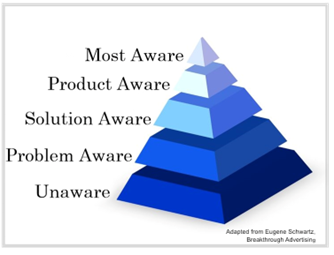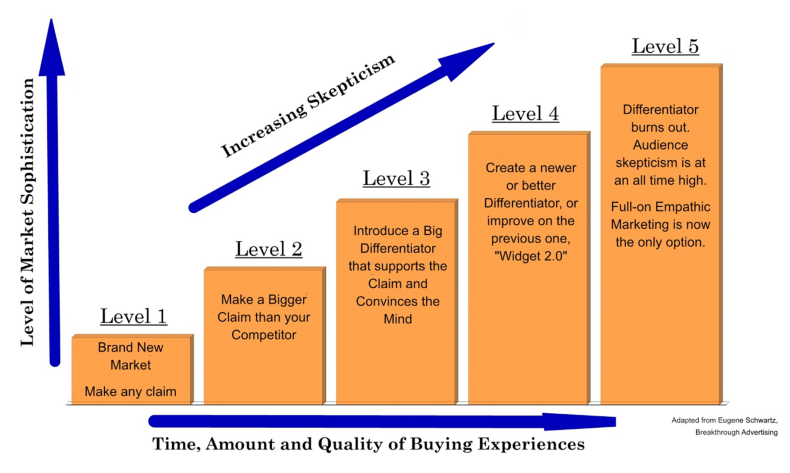In our increasingly digitalized and AI-centric world, businesses are grappling with maintaining meaningful connections with their customers.
Technology has brought about efficiency and convenience, but the human element is often sidelined.
Empathic marketing is a powerful strategy that puts understanding your audience's deeper needs at the forefront of your business interactions.
The approach, detailed in my book Empathic Marketing, is all about creating and nurturing authentic relationships by using your experiential and emotional understanding of your audiences.
For B2B marketers in particular, mastering the approach could be a gamechanger.
An Experiential Understanding of Your Prospects' Levels of Awareness
The journey of empathic marketing begins with a thorough understanding of your audience's levels of awareness, a concept borrowed from Eugene Schwartz's Breakthrough Advertising.
The approach equips businesses with the capability of crafting messages that resonate at a deep, empathetic level with their target audiences, meeting them precisely where they are in their awareness journey.
Consider this example from the B2B space: a company offering a unique AI-driven intrusion detection system (IDS) as a cybersecurity solution. By empathetically aligning marketing strategies with the customer's awareness level, businesses can foster a genuine connection and offer valuable solutions.
Level 1: Unaware
In this phase, potential customers might be blissfully unaware of potential gaps in their current cybersecurity measures. They haven't recognized the need for a more advanced solution like an AI-driven IDS.
An empathetic marketing message should take a subtle, educational approach, gently alerting them to the growing sophistication of cyber threats, creating a context where they realize there might be more to the story.
Level 2: Problem-Aware
The prospects at this level have a clear understanding of their cybersecurity issue but lack awareness of the range of available solutions. They comprehend the need for enhanced protection but are oblivious to AI-driven IDS as a potential solution.
In practicing empathic marketing, your message should empathize with their problem, creating a connection before you introduce the concept of AI-driven IDS as a potential answer to their predicament.
Level 3: Solution-Aware
At this level, potential customers are well versed in cybersecurity solutions, including AI-driven IDS, but they are unsure which to opt for.
Your empathetically crafted marketing message should highlight the unique benefits and advantages of your specific AI-driven IDS, not merely stating facts but also addressing emotions and feelings of security and ease that choosing your solution can provide.
Level 4: Product-Aware
Prospects at this juncture are knowledgeable about your AI-driven IDS solution and possibly other similar solutions, but they haven't resolved which provider to choose.
At this point, your empathetic marketing message should articulate what sets your company's AI-driven IDS apart, such as your big differentiator, superior customer service, or competitive pricing—emphasizing how those factors translate into tangible benefits and peace of mind for them.
Level 5: Most Aware
Prospects at this stage are familiar with your AI-driven IDS and then need only know the final details, such as pricing or implementation support, to make a purchase.
The empathic marketing approach insists that your message provide that information clearly and succinctly, without overwhelming them. Your communication should validate their decision, affirming the peace of mind and security they're about to achieve with your solution.

In essence, empathic marketing calls for not only understanding where your prospects are in their journey but also aligning your messages to resonate with their emotions and needs at each stage. It's about establishing a genuine, empathetic connection that places their needs and emotions at the forefront of your marketing strategy.
By understanding those levels of awareness, you can create targeted messages that address the specific concerns and needs of your prospects at each stage, making your marketing campaign more impactful and effective.
An Experiential Understanding of Your Market's Levels of Sophistication
Complementing the levels of awareness are the levels of sophistication, and empathic marketing calls for a keen understanding those sophistication levels. The concept, also derived from Breakthrough Advertising, equips businesses with the ability to refine their messages based on the market's saturation level and the audience's familiarity with the product or service.
At every level, the empathic marketer can recognize and address the nuances of the audience's mindset.
Let's delve deeper into our B2B example featuring an AI-driven IDS to clarify these sophistication levels and show how empathic marketing can transform communication with prospects.
Sophistication Level 1
As your AI-driven IDS steps into the market as a fresh concept, it evokes a sense of novelty. Your marketing message should tap into that excitement and focus on introducing your revolutionary solution.
An empathetic approach would highlight not only the unique benefits of AI-driven detection systems but also the peace of mind such cutting-edge technology offers.
Sophistication Level 2
When competitors begin launching similar solutions, your marketing message must stand out.
It's not just about showcasing specific features, additional services, or exceptional customer support that sets your AI-driven IDS apart; empathic marketing at this level means articulating how those unique aspects cater to users' needs, reducing their stress and enhancing their sense of security.
Sophistication Level 3
As the market becomes increasingly saturated and customers are exposed to repetitive pitches, you need to introduce a "big differentiator." That could be an innovative feature that drastically elevates the system's effectiveness, such as a predictive algorithm that proactively identifies threats.
However, practicing empathic marketing means also showing your customers that your differentiator will provide them with more control and a sense of proactiveness toward their cybersecurity concerns.
Sophistication Level 4
With market saturation comes growing skepticism. Your marketing messages must address it by enhancing your big differentiator, perhaps offering concrete proof of your solution's effectiveness, such as case studies or third-party validations.
Empathic marketing in this scenario goes a step further by acknowledging prospects' skepticism and demonstrating how your solution provides not just better results but also renewed confidence in their cybersecurity strategy.
Sophistication Level 5
When customers are highly skeptical and jaded from countless similar claims about AI-driven IDS, your marketing messages should introduce a groundbreaking approach or technology that amplifies your product's effectiveness.
That could be an additional tool or service that complements your AI-driven IDS, providing an even more robust cybersecurity solution.
Through empathic marketing, that message doesn't just propose a novel solution but also validates their skepticism and presents a more comprehensive, tailored solution that aims to restore their trust and give them peace of mind.

Thus, empathic marketing is not only about understanding where your prospects stand in their product familiarity but also about shaping your messaging to acknowledge their experiences, concerns, and emotions at every stage. The approach fosters a connection that transcends conventional marketing, bridging the gap between businesses and customers at an emotional level.
When you understand the levels of sophistication, you can finely tune your marketing message to address the specific concerns and needs of your audiences based on how familiar and saturated they are with your type of solution. You thereby increase the impact and effectiveness of your marketing campaign.
An Emotional Understanding: The 4Ds of Transformation Delivery
An integral part of empathic marketing involves acquiring your audiences' "4Ds of transformation delivery":
- Their immediate difficulties and desires
- Their long-term dreads and dreams
That method provides a comprehensive emotional understanding of your audience, enabling you to craft marketing messages that truly resonate with them.
Let's delve into the 4Ds:
- Difficulties. These are the immediate challenges your audience faces. In a B2B context, it could be anything from streamlining operations, integrating new technologies, and managing remote teams to staying competitive in the market.
By identifying your audience's difficulties, you can position your product or service as a solution to those immediate issues, making it relevant and valuable.
- Desires. These are the short-term wants of your audience. For instance, a business might desire to increase its market share, improve productivity, or enhance customer satisfaction.
Understanding those desires allows you to align your offerings with the business's goals, emphasizing how your product or service can help achieve them quickly and efficiently.
- Dreads. These are the long-term fears or concerns of your audience. In a B2B context, they could include fears of being outpaced by competitors, failing to adapt to market changes, or even going out of business as a consequence of unforeseen circumstances.
By understanding those dreads, you can craft messages that highlight the preventive and protective features of your offerings, thereby reassuring your audience.
- Dreams. These are the long-term goals or aspirations of your audience. For a business, that could be becoming an industry leader, expanding to new markets, or building a globally recognized brand.
By tapping into prospects' dreams, you can position your product or service as a catalyst or tool to help them reach those lofty goals.
By exploring the 4Ds and incorporating them into your marketing messages, you can ensure your campaigns are finely tuned to your audience's immediate needs and future aspirations. That results in deeper connections, greater relevance, and, ultimately, more successful campaigns.
* * *
By harnessing the experiential and emotional understanding of your market, B2B marketers can design unique and persuasive campaigns.
By deeply understanding the audience's awareness, sophistication, and the 4Ds of Transformation, marketers can address present concerns and future aspirations. The approach fosters genuine connections, builds trust, and drives success by resonating with audience emotions, desires, and needs.
Empathic marketing doesn't just make your brand stand out—it creates meaningful, enduring relationships in the competitive business landscape.
More Resources on Empathy in Marketing
The Role of Customer Empathy in the Future of Marketing




